This post may contain affiliate links. Please read my disclosure policy.
All about how we introduced solids to our daughter, Skylar! Check out the details, including our hopes, fears, product favorites, recipe hits, and more.
Starting to feed your baby solids is such a big milestone… and you’d think that with my job, I would have been over-the-top psyched about it, right?
Well, here’s the truth: I was (of course) excited for this big transition, but my anxiety kind of got the best of me. Actually, I was mostly TERRIFIED. So, now that we have a few months behind us, I thought I’d share with you our approach to starting solids with Skye, how we started, how it’s going, and more.
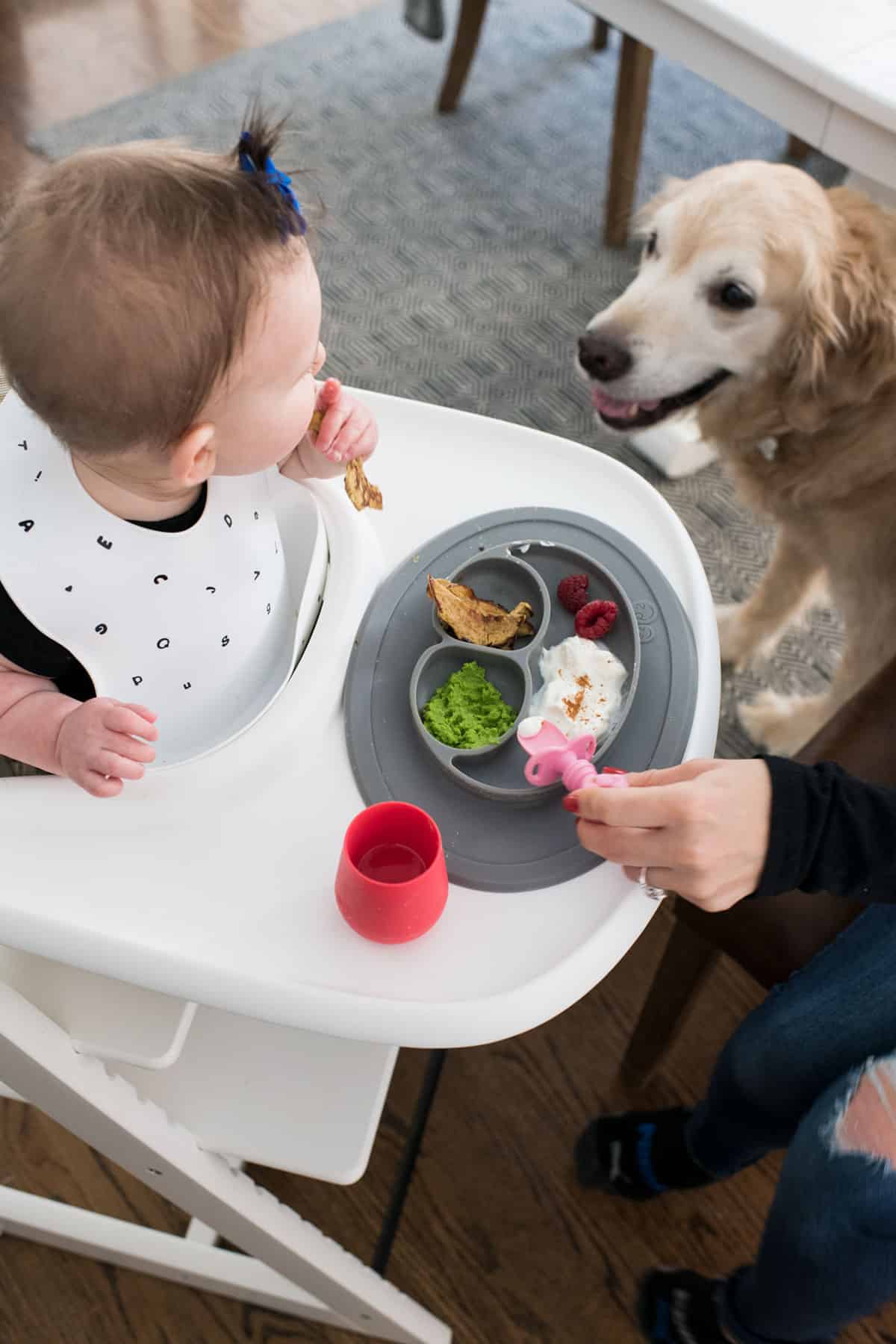 Pictured: Stokke Trip Trap High Chair, Mushie bib, EZPZ open cup, EZPZ plate (not my favorite for high chair), Bumpkins Chewtensil
Pictured: Stokke Trip Trap High Chair, Mushie bib, EZPZ open cup, EZPZ plate (not my favorite for high chair), Bumpkins Chewtensil
How We Started Solids for Skylar
Disclaimer: I am not a doctor. I’m just a mama who is sharing what has worked best for our family. Keep in mind that every child is different. Always consult with your little one’s pediatrician and — in this case — a feeding specialist, if need be. Ultimately, you need to do whatever you feel comfortable with, no matter what you see or hear!
SHORTCUT KEY:
LO: Short for Little One!
BLW: Baby Led Weaning
BLP: Baby Led Purees
Methods for Introducing Solids
The Academy of Pediatrics (AAP) recommends exclusive breast-feeding or formula-feeding for the first six months after birth. By around six months of age, most babies are ready to begin eating solid foods as a complement to breast-feeding or formula-feeding. Ask your child’s pediatrician if your baby is ready for solid food! Some parents opt to introduce solids with purées, others follow a baby-led weaning method, and some do a combination. Once ready, decide what method will work for YOU.
Traditional Purees:
This speaks for itself, really. It’s the process or method of steaming and then pureeing fruit, vegetables, or cooked meat/chicken/fish. You can thin out mixtures with breastmilk or formula if needed/desired.
Baby-Led Weaning (BLW):
Baby-led Weaning is a method of feeding where you skip the spoon-fed puree phase and go straight into solids — age-appropriate foods softly cooked and cut into pieces your baby can pick up on their own. The goal of BLW is to have babies begin to eat what you eat pretty quickly, which can make life a lot easier, since you’re not shopping for and preparing other foods. You also skip the spoon-feeding step. Some argue that BLW babies are able to fine tune their motor skills earlier than others. There’s a whole lot of information and tips about BLW out there if you decide that’s the method for you! I would suggest reading more about BLW on the internet (here is a resource I like).
Baby-Led Purees (BLP):
In this method, you cook the food via steaming and then puree it. After that, you let your baby take the lead with the actual feeding process. You’re making purees, but you aren’t spoon feeding.
BLISS Method:
According to Pediatrics AAP Publications, “BLISS is a form of baby-led weaning (i.e., infants feed themselves all their food from the beginning of complementary feeding) modified to address concerns about choking risk.”
So what method of introducing solids did we go with?
Ultimately — and after a lot of research! — I decided to combine BLP & BLW in what they call the BLISS method.
Here’s the thing: I wanted to dive headfirst into BLW. I really did! But I was constantly stressed about Skylar choking. Even after reading, reading, and more reading — and knowing as much as I could about infant CPR — I was still worried and I was exhausting myself. Since your baby can pick up on stress (take a nice deep breath, mama or dada!), I decided to stop going down the full BLW road and instead to go with my mommy gut. I did some more research and made the best decision for our family (which was a combination). It will be different for everyone!
I decided that, whether or not I gave her a whole chicken drumstick on day one, my goal was the same. By nine months I wanted her to be eating what we are eating.
Here’s what I’d like any new parent reading this to come away with:
Are there benefits to starting your LO with baby-led weaning over traditional purees? Perhaps! Will people tell you there’s only one safe way to start (and that it’s the right way)? Absolutely. Will your extended family agree with every choice you make? Likely not. But YOU are the parent. Period. Bottom line. You make the rules! You get to decide what YOU are comfortable with. You get to educate yourself. You know your baby! Regardless of how you start to feed your child, it will all work out! Don’t compare yourself to strangers on the internet!
So here’s how we actually started…
- Skylar was showing signs of readiness (see FAQs below or do a quick Google search) just before she hit six months, so we started her with purees/mashes, sitting up in her high chair, with her assisting the eating. We started with banana, then moved on to butternut squash, avocado, pears, apples, peas, sweet potato, carrots — all in a mix of pureès, mashes, and little soft pieces (spears, if I could handle it — she shovels). After a few fruits/veggies, we added in allergens, including yogurt, nut butter, and eggs.
- After Skye got used to the idea of food in her mouth — this definitely took a week or two — I tried to add one safe thing at every meal, like a quartered blueberry that had been lightly mashed between my fingers.
- From there, I started making banana, egg, and cinnamon ‘pancakes’. They essentially melt in your mouth, so it was low-stress and I would cut them into strips for her.
- After about two weeks, Skye was over purees — plus, I was more confident, so we were doing great and easing into a BLW approach.
- At this point, Skylar eats what we eat. I just add salt and spice for us after setting her portions aside!
Note 1: You’ll notice that I didn’t start with infant rice cereal, even though many pediatricians recommend that. This was a personal choice to go straight for nutrient-dense real food and iron from meet instead of specific baby foods. Do WHATEVER works for you.
Note 2: (This was a big question from all of you!) The first week or so, Skye was really just experimenting and getting used to the idea of new textures in her mouth. She didn’t eat full meals… not even close! But after a week or two, she started eating more. Don’t worry if on day one, your LO isn’t eating a feast. They have a tongue thrust reflex that automatically pushes food out of their mouth, but they’ll grow out of it. Plus, they’re probably wondering what this crazy new texture in their mouth is. Can you blame them?
Note 3: You may have heard that you should start with savory vegetables instead of fruits so your LO will develop a palette for things that aren’t sweet. I think that’s been proven a big myth! Skylar’s first food was banana and she also eats vegetables. Just make sure your LO is trying a wide variety of foods.
Can’t make your own purees?
As you’ll see below, I didn’t buy a baby food maker, as I decided I didn’t want another piece of kitchen equipment or something extra to clean. For purees/mashes, I made my own and used the steamer insert in my Always pan (best feature!) and our Vitamix blender.
I made my own purees and mashes and didn’t buy baby food, but if you don’t want to or can’t, I love the brand My Serenity Kids. I always have their pouches (and puffs) on hand since they are nutrient dense and I trust their ingredients and process, which is a big deal in the baby food industry. I even use their pouches as a sauce for lentil pasta! I am excited that they offered a discount code for you all. Use code LEXI15 for 15% off at checkout!
Other things worth sharing:
- I didn’t/don’t scrape food off her face and did not force-feed her. As in, I never forced/put food into Skylar’s mouth, even when we fed purees. I let her lead this.
- I did dump purees directly on her high chair and let her explore. It was messy, but really good for sensory development. Here’s a good read on letting your LO get messy!
- I put the food on Skylar’s spoon, then either handed it to her or set the spoon on her high chair, so that she could bring the food to her mouth by herself. This method still allows her to develop fine motor skills. Somewhere along the way, we ditched the spoon, but we’re working on using it a bit more now, at around the ten-month mark.
As your baby gets older:
Whichever method you start with, as your LO continues on their solids journey, they can eventually start eating the same foods you are eating — with a few modifications. As they get towards 9-to 12-months, your LO will ideally be eating a grain or vegetable starch, a protein, and a fruit or vegetable at every meal. And just remember to avoid choking hazards! And also, if you need to hear this, if every single meal is not perfectly balanced, it’s OKAY.
My Approach to Allergens:
After doing some research, I found it’s no longer recommended to wait to introduce allergenic foods. I introduced allergenic foods right when we started our food journey! That being said, please check with your pediatrician before you jump in, especially if your baby is at risk for allergies (runs in family, eczema, reacted to breast milk, etc).
Tips:
- Only introduce allergenic foods when your LO will be awake for a few hours so you can keep an eye out for any reactions.
- Offer each food two or three times without mixing it with any other allergic foods. For example, I knew we were okay with banana, so banana and yogurt was a safe try, since I knew she wasn’t going to react to banana. I didn’t mix yogurt and peanut butter until I knew we were in the clear with both.
- If your baby reacts with hives, rash, difficulty breathing, or anything that doesn’t seem normal, call your doctor or take action immediately.
- When in doubt (for the really anxious), offer an allergen on the day of a doctor appointment. Why not, right?
The Printable I Really Liked
I printed out this document and checked off various foods and allergens as we tried them. I also liked having this on hand should anyone (family, etc.) have needed to feed Skylar in the beginning. Though as we moved into real solids, I was most comfortable if I was the one feeding her.
There’s a few things not on there, but it’s a great starting point!
Choking vs. Gagging
Choking is very different from gagging. It is worth educating yourself and taking an infant CPR course and watching videos online as your baby is approaching this milestone. Choking occurs when their airway passage is blocked. When choking, your LO will make no noise, look scared, and turn blue. Gagging is normal and safe. Choking is not.
Always avoid choking hazards and cut foods depending on age. Try to stay calm if your LO is coughing and let them work it out. Fun fact: Babies at this age have their gag reflex more in the front of their mouth, so they do a good job of getting food to the front. I always show Skylar what to do if I think she has a big piece, showing her she can stick her tongue out and spit it out if she needs to. Let them gag and don’t try to intervene and pull the food out of their mouth, since you could actually lodge the food further down their throat and cause them to choke if you do this. Be present and aware!
P.S. I NEVER buckled Skylar into her high chair, in case I needed to grab her out in an emergency.
Skylar was so tiny in these early eating days!!!!!!
Recipes Skylar Gobbles Up
Skylar has a version of pretty much everything we eat! I adjust for excess sodium and cut things up for her age. Favorites include:
- Sweet Potato Chili
- Classic Chicken Soup (Slow Cooker & Instant Pot)
- Healthy Turkey Chili
- The Best Paleo Pancakes
- Gluten Free Turkey Meatballs with Spinach
- Easy Homemade Refried Beans
- The Ultimate Guide on How to Make Oatmeal
- Curry Chicken
- Taco Meat
- Tropical Smoothie
- Pesto
- Hard Boiled Eggs
- Oatmeal Bake (omit sweetener/chocolate chips)
I simply adjust the salt and spice for Mike and myself after setting Skye’s portions aside! For example, I make the chili with no salt and less spice than directed. I set hers aside and adjust salt and spices for the adults.
Other foods we serve:
- All different fruits (cut according to age)
- Roasted veggies (cut according to age)
- Toast with thin nut butter or hummus (cut according to age)
- Beans
- Steamed broccoli
- Lentil or chickpea pasta with extra virgin olive oil, sauce, pesto, or a pouch as sauce
- Eggs
- Spaghetti squash with easy meat sauce
- Greek yogurt with nut butter, cinnamon, and banana
- Cooked fish
- Cucumbers (see example here from Solid Starts how to cut it by age)
- Hummus
- Ricotta cheese
- Avocado
- Sautéed ound turkey or beef with onions, peppers, and spices
Products We Love
NOTE: I did not buy a separate baby food maker.
- A safe pan: I love steamer insert in my Always Pan
- Blender: Vitamix blender
- High Chair: Stokkke Tripp Trapp High Chair
- On-The-Go Seat: Bumbo Chair Seat: Attaches to any chair so it’s really great for on-the-go.
- Plates: I’ve tried so many and my favorites are Bumpkins, Lalo, and Avanchy.
- Utensils: I have the Bumpkins Chewtensils, Munchkin, and Avanchy.
- Cups: I use this open cup, the one that came in my Lovevery subscription box, and this straw cup. She learned how to use the straw cup with this particular straw cup.
- Bibs: I use these and these.
- High Chair Mat: I actually just have an old (somewhat harder) yoga mat under it.
- Storage Containers: I love these glass ones!
- Cleaning: Dyson Vacuum and Branch Basics cleaning products (15% off with code LEXI15). Enough said. Also, thank heaven for dogs!
You can see more in the Baby Feeding category on my Amazon Storefront!
Accounts & Websites I Love
- Solid Starts Website & Instagram – probably my most used website resource
- Feeding Littles Website (great course) & Instagram
- Happy Healthy Eaters on Instagram
- Infant Nutritionist on Instagram
- Baby Led Feeding on Instagram
- Mama Knows Nutrition on Instagram
- Kids Eat in Color on Instagram
- Mada Leigh on Instagram
- Baby Led Wean Team on Instagram
- Yummy Toddler Food on Instagram
FAQs (that I had and also heard from you!):
When do I start feeding my baby?
Always consult with your pediatrician. They’ll likely bring it up at your LO’s six-month visit, if not before. Here are some signs that your little one may be ready for food:
- Baby is at least six months old.
- Baby can sit upright unassisted and hold up their head.
- Baby is curious and looking at everything around them… especially what you’re eating!
How many meals do I start with?
It’s recommended to start with one or two, then to add in a third meal over time. At this point (ten months), Skylar has been eating three meals a day for quite some time. Her high chair sits at our table, and we all eat dinner together. She loves sitting at the table with us eating, and I think it’s important for her to see us eating together as much as possible!
How much food is too much?
Babies are the ultimate intuitive eaters!! Give small portions and add more if they’re still going for it. They’ll stop themselves when they are full.
My baby isn’t super into food and I’m freaking out.
There are some days Skylar eats less and some days she eats more. I’ve found that for her, it’s usually related to teething, but every baby is different. Don’t compare meal sizes to what you see on the Internet! If you’re concerned, chat with your pediatrician.
Does Skylar like everything?
So far, on the “not loving” list, we have… salmon, avocado, and scrambled eggs. Some days, she is into a specific food and other days, she’s just not. Sometimes, she devours blueberries, but lately, not so much. I just roll with it and keep trying those foods each week. I don’t stress too much about it!
How do I cut foods to prevent choking?
Though I have this down now, I’m not the expert here, so definitely go to the experts like I did! When in doubt, I use the Solid Starts food database, which shows a food’s nutrition, level of a choking hazard, how to cut things by age/food, and more! It’s a great resource with videos, etc.
I learned this nugget, I believe, from Feeding Littles: To know if your LO can eat it, see if it is soft/can mush to the roof of your mouth. That generally means they can gum it. A pinch test should work, too. The food should be soft enough so you can touch your fingers together if you pinch the food hard enough.
When should I add water? How Much?
It’s important to note that breast milk or formula is the main hydration for the first year. We have offered sips of water from the start (about six months). A small amount of water can help with digestion and constipation, and also to wash down food! Sippy cups aren’t the best for feeding development from my research, so we started with an open cup (with assistance) and moved on to a straw cup. I actually offer both at mostly every meal. Now at almost ten months, she’s starting to drink more water, I always have her cup(s) filled up with a few ounces. She also loves taking sips or drinking out of our glasses.
Do I just go for it with spices?
I definitely spice her food, minus heat and salt! Babies don’t digest sodium the same way as we do, so I just watch her salt intake. We joke that Skylar is eating curry and some flavors that Mike and I didn’t eat until our teenage years. I’ll add a little cinnamon onto her yogurt… why not?
How did you work on the pincer grasp?
Not sure what this is? The pincer grasp is defined as a grasp that uses the pads then tips of the index finger and thumb to pick up and grasp objects. We worked on it pretty much all the time. If there was a food that was too slippery (piece of avocado for example), I would roll it in flax or hemp hearts to help. I love My Serenity puffs for practicing, too! Use LEXI15 for 15% off at checkout.
Are you still nursing the same amount?
Up until recently, yes! Now, I feel like Skylar is nursing less at each meal and I feel like she doesn’t really need the feed after her second nap. When she’s popping a tooth she wants to breastfeed more, but otherwise they’re much shorter feeds lately.
Here’s our current schedule, as Skye is about nine and a half months old*:
- 7:00am: Wake and immediately breastfeeds
- 8:00am: Breakfast
- 10:00: Nap 1
- 11:30pm: Breastfeeds
- 12:30pm: Lunch
- 2:00pm: Nap 2
- 3:30pm: Breastfeeds
- 5:00pm: Dinner
- 7:00: Breastfeeds then bed
*Timing may vary by roughly thirty minutes based on naps (thank you, Molly!) and I just adjust accordingly.
I hope this is helpful! If you have more questions, leave them in the comments below!
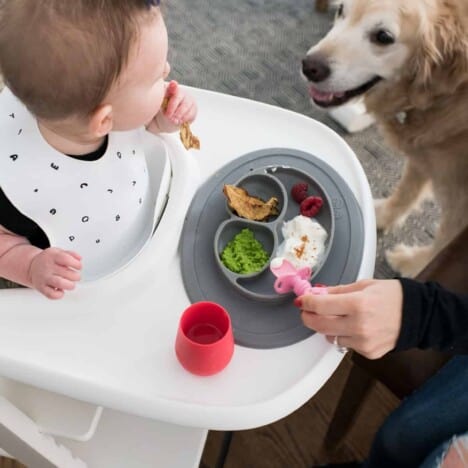
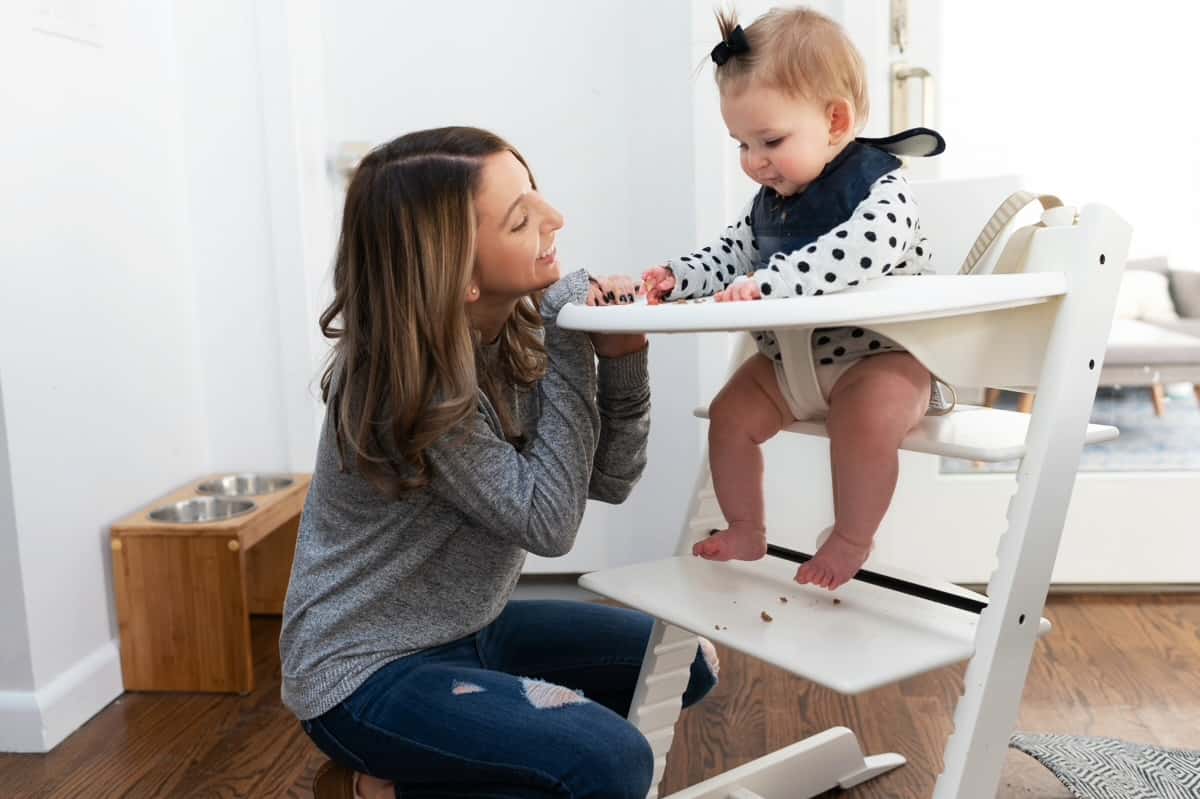
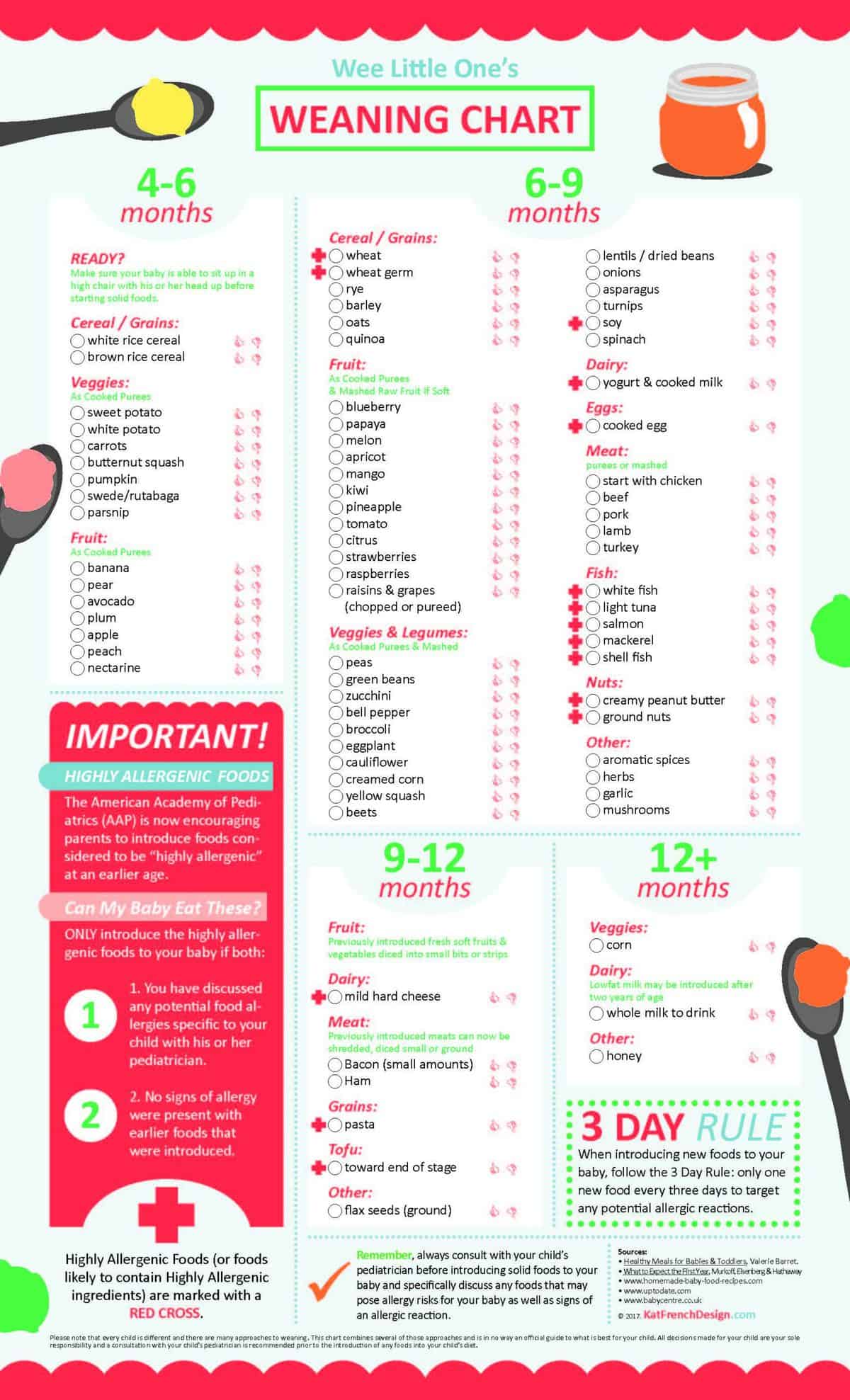
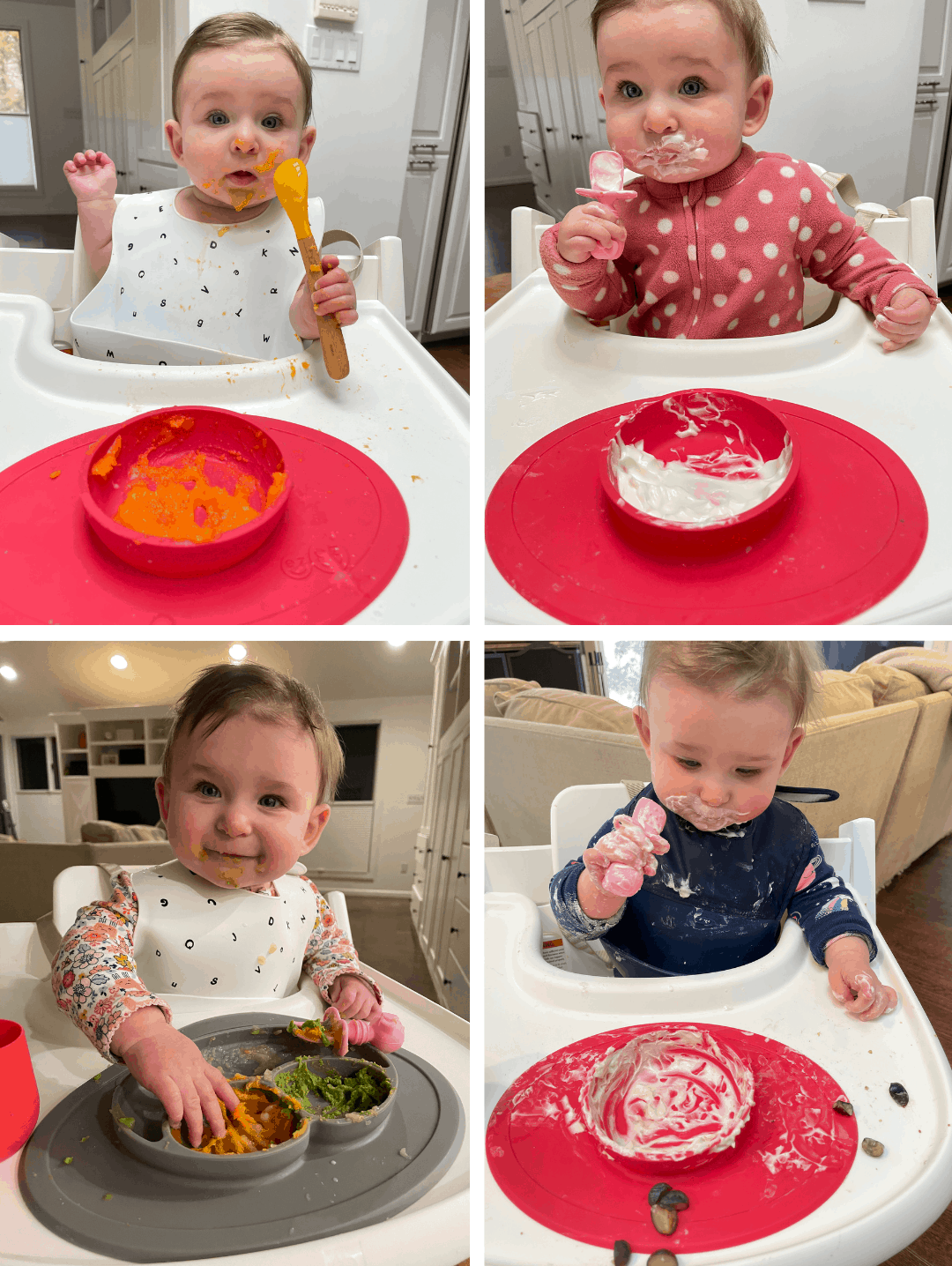



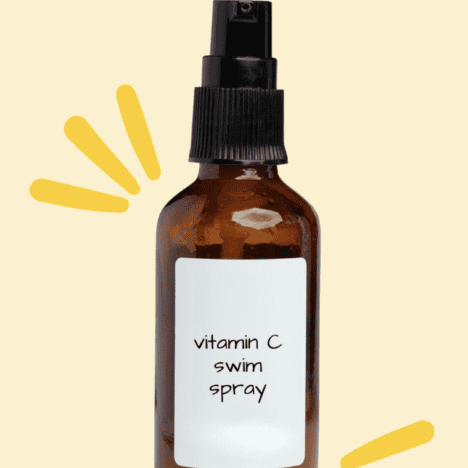
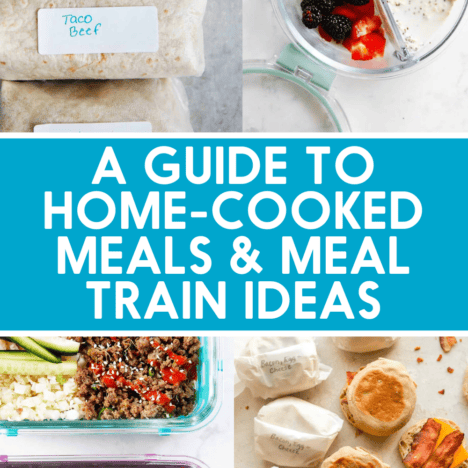

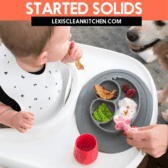
This is a great resource! Thank you so much. Feeding our LO gives me so much stress!!
Skylar is ADORABLE!!! This is such a fantastic resource for new parents. I wanted to come say that it is awesome you are exposing her to so many different foods and flavors – when my son began eating solid foods, I gave him all sorts of things – mild curries, Lima beans, broccoli,etc. I wanted to give him exposure to a variety of foods to develop his palate. He is 12 now and eats almost everything, and is willing try anything at least once. His friends are super picky and won’t eat anything anything at our house except cereal and bars! My point being – it’s so valuable to expose kids to different things when they’re learning to eat because it helps ensure they eat something besides hot dogs and macaroni and cheese!
YES! Thank you for sharing this!